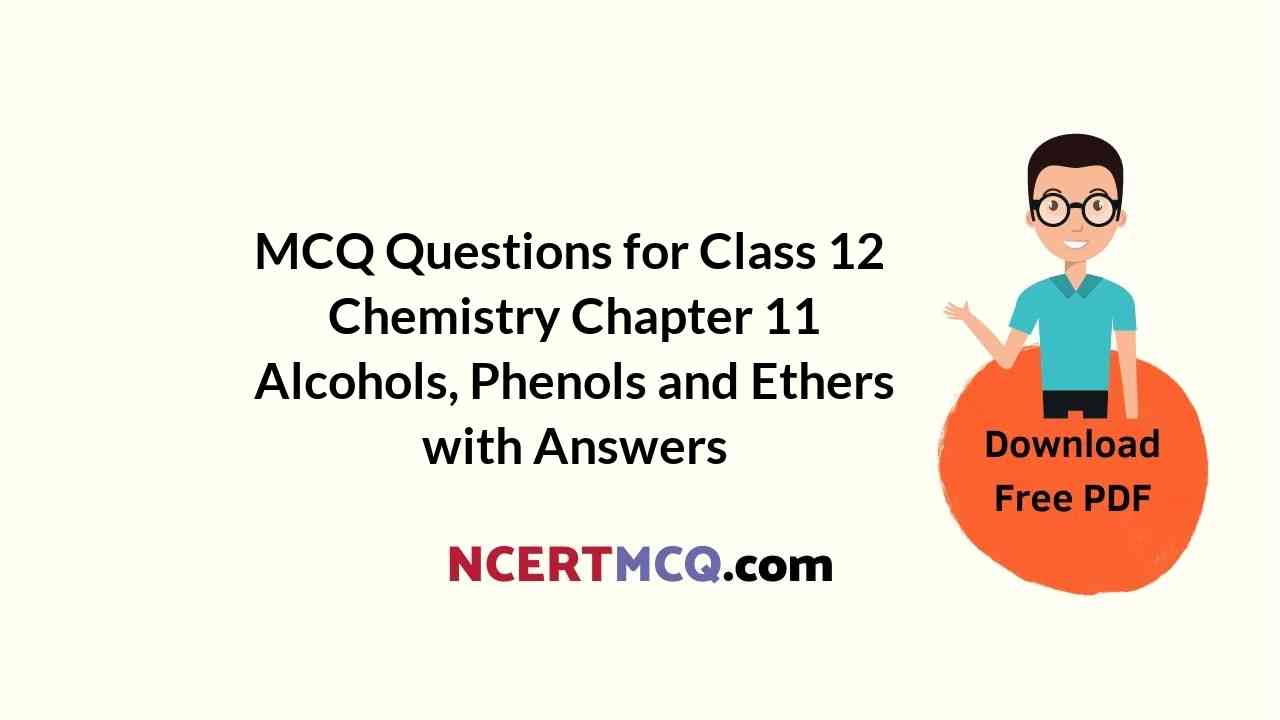Check the below NCERT MCQ Questions for Class 12 Chemistry Chapter 11 Alcohols, Phenols and Ethers with Answers Pdf free download. MCQ Questions for Class 12 Chemistry with Answers were prepared based on the latest exam pattern. We have provided Alcohols, Phenols and Ethers Class 12 Chemistry MCQs Questions with Answers to help students understand the concept very well.
Class 12 Chemistry Chapter 11 MCQ With Answers
Chemistry Class 12 Chapter 11 MCQs On Alcohols, Phenols and Ethers
Alcohol Phenol And Ether MCQ Question 1.
Which of the following alcohols gives 2-butenc on dehydration byconc. H2SO4?
(a) 2-methyl propene-2-ol
(b) 2-methyl 1 -propanol
(c) Butane-2-ol
(d) Butane 1-ol
Answer
Answer: (c) Butane-2-ol
Alcohol Phenol And Ether MCQ Class 12 Question 2.
One mole of ethyl acetate on tatment with an excess of LiAlH4 in dry ether and subsequent acidification produces
(a) 1 mole acetic acid + 1 mole ethyl alcohol
(b) 1 mole ethyl alcohol + 1 mole methyl alcohol
(c) 2 moles of ethyl alcohol
(d) 1 mole of 2-butanol
Answer
Answer: (c) 2 moles of ethyl alcohol
Alcohol Phenol And Ether MCQ With Answers Pdf Question 3.
Which of the following reagents can not, be used to oxidise primary alcohols to aldehydes?
(a) CrO3 in anhydrous medium
(b) KMnO4 in acidic medium
(c) Pyridinium chlorochromate
(d) Heat in the presence of Cu at 573 K
Answer
Answer: (b) KMnO4 in acidic medium
Alcohols Phenols And Ethers Class 12 MCQ Question 4.
1-Phenylethanol can be prepared by the reaction of benzaldehyde with
(a) methyl bromide
(b) ethyl iodide and magnesium
(c) methyl iodide and magnesium (Grignard reagent’s)
(d) methyl bromide and aluminium bromide
Answer
Answer: (c) methyl iodide and magnesium (Grignard reagent’s)
Alcohol Phenol Ether Class 12 MCQ Question 5.
Which of the following alcohols will give the most stable carbocation during dehydration?
(a) 2-methyl-1-propanol
(b) 2-methyl-2-propanol
(c) 1-Butanol
(d) 2-Butanol
Answer
Answer: (b) 2-methyl-2-propanol
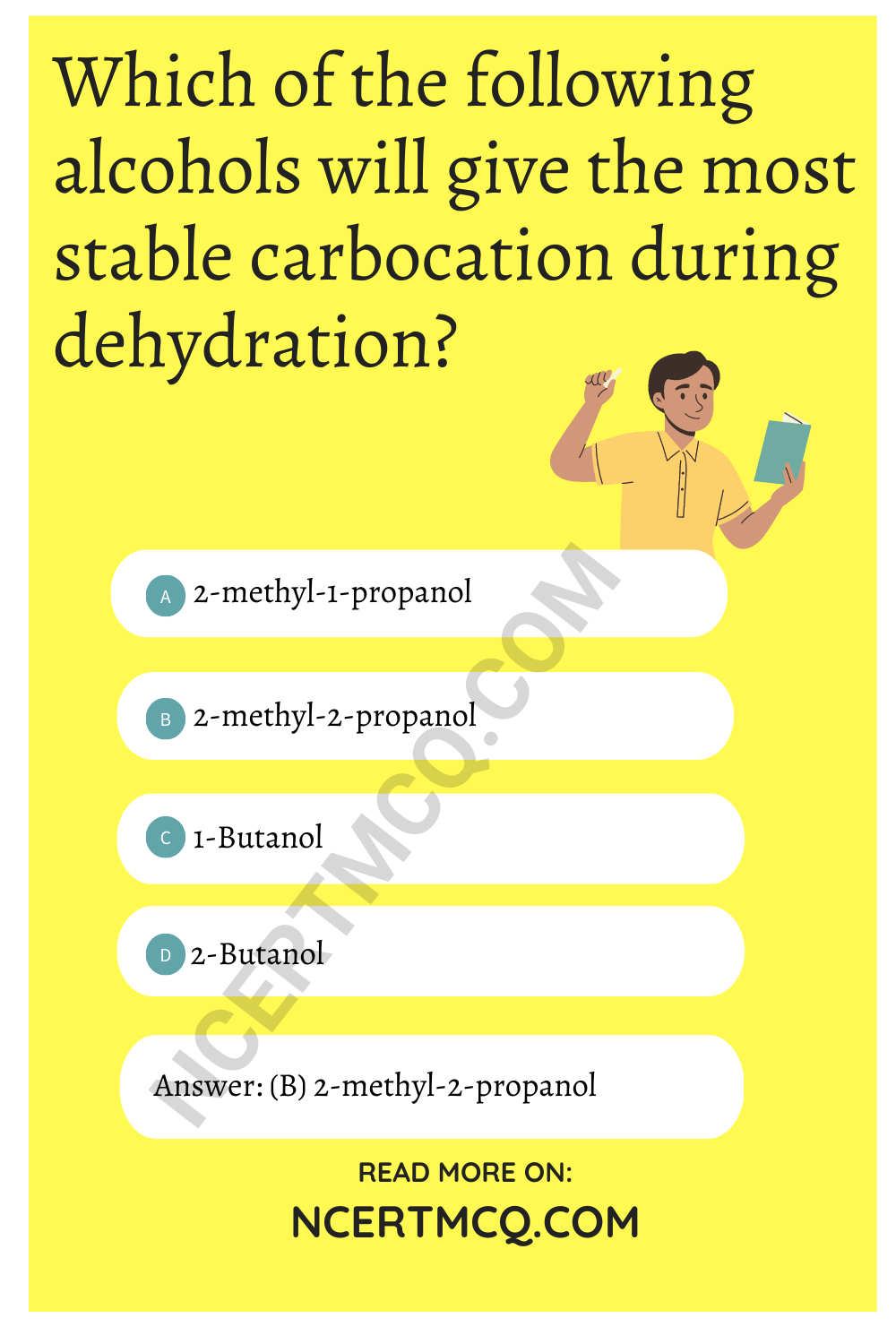
MCQ On Alcohol Phenol And Ether Question 6.
A compound X with the molecular formula C2H8O can be oxidised to another compound Y whose molecular formulae is C3H6O2. The compound X may be
(a) CH3CH2OCH3
(b) CH3CH2CHO
(c) CH3CH2CH2OH
(d) CH3CHOHCH3
Answer
Answer: (c) CH3CH2CH2OH
MCQ Of Alcohol Phenol And Ether Question 7.
Order of esterification of alcohols are
(a) 3° > 1° > 2°
(b) 2°> 3° > 1°
(c) 1 ° > 2° > 3°
(d) None of these
Answer
Answer: (c) 1 ° > 2° > 3°
Alcohols Phenols And Ethers MCQs Question 8.
What happens when tertiary butyl alcohol is passed over heated copper at 300°C?
(a) Secondary butyl alcohol is formed
(b) 2-methylpropene is formed
(c) 1-butene is formed
(d) Butanol is formed
Answer
Answer: (b) 2-methylpropene is formed
Alcohol Phenol And Ether MCQ With Answers Question 9.
Which of the follow ing compounds will be most easily attacked by an electrophile?
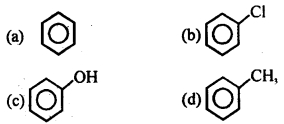
Answer
Answer: (c)
Class 12 Chemistry Chapter Alcohol Phenol And Ether MCQ Question 10.
![]()
In the reaction, X is
(a) (CH3)2C = CHCH3
(b) CH3C = CH
(c) (CH3)2CHCH2CH3

Answer
Answer: (a) (CH3)2C = CHCH3
Ans. a
MCQ Questions On Alcohol Phenol And Ether Question 11.
What would be the reactant and reagent used to obtain 2, 4-dimenthyl pentan-3-ol?
(a) Propanal and propyl magnesium bromide
(b) 3-methylbutanal and 2-methyl magnesium iodide
(c) 2-dimethylpropanone and methyl magnesium odide
(d) 2-methylpropanal and isopropyl magnesium iodide
Answer
Answer: (d) 2-methylpropanal and isopropyl magnesium iodide
Alcohols Phenols And Ethers Class 12 MCQ Questions Question 12.
The decreasing order of boiling point of the following alcohols is
(a) 3-methylbuan-2-ol > 2-methylbutan-2-ol > pentan-1-ol
(b) Pentan-1-ol > 3-methylbutan-2-ol > 2-methylbutan-2-ol
(c) 2-methylbutan-2-ol > 3-methylbutan-2-ol > pentan-1-ol
(d) 2-methylbutan-2-ol > pental-1-ol > 3-methylbutan-2-ol
Answer
Answer: (b) Pentan-1-ol > 3-methylbutan-2-ol > 2-methylbutan-2-ol
Alcohols Phenols And Ethers MCQ Question 13.
Acid catalysed dehydration of t-butanol is faster than that of n-butanol because
(a) tertiary carbocation is more stable than primary carbocation
(b) primary carbocation is more stable than tertiary carbocation
(c) t-butanol has a higher boiling point
(d) rearrangement takes place during dehydration of t- butanol
Answer
Answer: (a) tertiary carbocation is more stable than primary carbocation
MCQs On Alcohols Phenols And Ethers Question 14.
An unknown alcohol is treated with “Lucas reagent” to determine whether the alcohol is primary, secondary or tertiary. Which alcohol reacts fastest and by what mechanism?
(a) Tertiary alcohol by SN2
(b) Secondary alcohol by SN1
(c) Tertiary alcohol by SN1
(d) Secondary alcohol by SN2
Answer
Answer: (c) Tertiary alcohol by SN1
MCQ Alcohol Phenol Ether Class 12 Question 15.
An alcohol X when treated with hot cone. H2SO4 gave an alkene Y with formula C4H8. This alkene on ozonolysis gives single product with molecular formula C2H4O. The alcohol is
(a) butan-1-ol,
(b) butan-2-ol
(c) 2-methylpropan-1-ol
(d) 2,2-dimethylbutynal-1-oI
Answer
Answer: (b) butan-2-ol
MCQ Questions On Alcohols Phenols And Ethers Question 16.
Which of the following alcohols reacts most readily with Lucas reagent?
(a) CH3CH2CH2OH
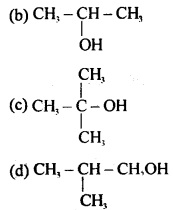
Answer
Answer: (c)
MCQ Alcohol Phenol And Ether Question 17.
Propanone on reaction with alkyl magnesium bromide followed by hydrolysis will produce
(a) primary alcohol
(b) secondary alcohol
(c) tertiary alcohol
(d) carboxylic acid
Answer
Answer: (c) tertiary alcohol
Alcohol Phenol And Ether MCQ With Answers Pdf Download Question 18.
Vapours of an alcohol X when passed over hot reduced copper, produce an alkene, the alcohol is
(a) primary alcohol
(b) secondary alcohol
(c) tertiary alcohol
(d) dihydric alcohol
Answer
Answer: (c) tertiary alcohol
MCQ Questions For Class 12 Chemistry Chapter 11 Question 19.
Phenol when treated with excess of bromine water gives a white precipitate of
(a) 2, 4, 6-tribromophenol
(b) o-bromophenol
(c) p-bromophenol
(d) bromobenzene
Answer
Answer: (a) 2, 4, 6-tribromophenol
Class 12 Alcohols Phenols And Ethers MCQ Question 20.
Picricacid is a yellow coloured compound. Its chemical name is
(a) m-nitrobenzoic acid
(b) 2, 4, 6-trinitropheriol
(c) 2, 4, 6-tribromophenol
(d) p-nitrophenol
Answer
Answer: (b) 2, 4, 6-trinitropheriol
Question 21.
Ortho-nitrophenol is less soluble in water than, p- and m- nitrophenols because
(a) o-nitrophenol shows intramolecular H-bonding
(b) o-nitrophenol shows intermolecular H-bonding
(c) melting point of o-nitrophenol is lower than those of m- and p-isomers
(d) o-nitrophenol is more volatile in steam than those of m- and p-isomers
Answer
Answer: (a) o-nitrophenol shows intramolecular H-bonding
Question 22.
The best reagent to convert pent-3-en-2-ol into pent-3-en- 2-one is
(a) acidic permanganate
(b) acidic dichromate
(c) chromic anhydride in glacial acetic acid
(d) pyridiriium chlorochromate
Answer
Answer: (d) pyridiriium chlorochromate
Question 23.
Identify the final product of the reaction sequence.
![]()
(a) Benzophenone
(b) Acetophenone
(c) Diphenyl
(d) Methyl salicylate
Answer
Answer: (b) Acetophenone
Question 24.
Arrange the following alcohols in order of increasing reactivity towards sodium metal.
(i) (CH3)3C-OH
(ii) (CH3)2CH-OH
(iii) CH3CH2OH
(a) (iii) < (ii) < (i)
(b) (ii) > (i) < (iii)
(c) (i) < (ii) < (iii)
(d) (iii) < (i) < (ii)
Answer
Answer: (c) (i) < (ii) < (iii)
Question 25.
The reaction between phenol and chloroform in the presence of aqueous NaOH is
(a) nucleophilic substitution reaction
(b) electrophilic addition reaction
(c) electrophilic substitution reaction
(d) nucleophilic addition reaction
Answer
Answer: (c) electrophilic substitution reaction
Question 26.
The most suitable reagent for the conversion of RCH2OH → RCHO is
(a) K2Cr2O7
(b) CrO3
(c) KMnO4
(d) PCC
Answer
Answer: (d) PCC
Question 27.
In the following reaction sequence Z is

(a) butan-1-ol
(b) butan-2-ol
(c) 2-methylpropan-2-ol
(d) 1, 1-dimethylethanol
Answer
Answer: (c) 2-methylpropan-2-ol
Question 28.
The major product of acid catalysed dehydration of 2-methylcyclohexanol and butan-1-ol are respectively
(a) 1 -methylcyclohexene andbut-1-ene
(b) 2-methylcyclohexene and but-2-ene
(c) 2-methylcyclohexene and butane
(d) 1-methylcyclohexene and but-2-ene
Answer
Answer: (a) 1 -methylcyclohexene andbut-1-ene
Question 29.
Tertiary butyl alcohol gives tertiary butyl chlorideon treatment with
(a) Conc HCl/anhydrous ZnCl3
(b) KCN
(c) NaOCl
(d) Cl2
Answer
Answer: (a) Conc HCl/anhydrous ZnCl3
Question 30.
Which of the following alcohol is dehydrated most easily with cone. H2SO4?
(a) p-O2NC6H4CH(OH)CH3
(b) p-ClC6H4CH(OH)CH3
(c) p-CH3OC6H4CH(OH)CH3
(d) C6H5CH(OH)CH3
Answer
Answer: (c) p-CH3OC6H4CH(OH)CH3
Question 31.
Conversion of phenol to salicyclic acid and to salicyaldehyde are known as (respectively)
(a) Reimer-Tiemann reaction and Kolbe’s reaction
(b) Williamson’s synthesis and Hydrobration-oxidation
(c) Kolbe’s reaction and Williamson’s synthesis
(d) Kolbe’s reaction and Reimer-Tiemann reaction
Answer
Answer: (d) Kolbe’s reaction and Reimer-Tiemann reaction
Question 32.
Which of the following is phenol?
(a) Cresol
(b) Catechol
(c) Benzenol
(d) All of these
Answer
Answer: (d) All of these
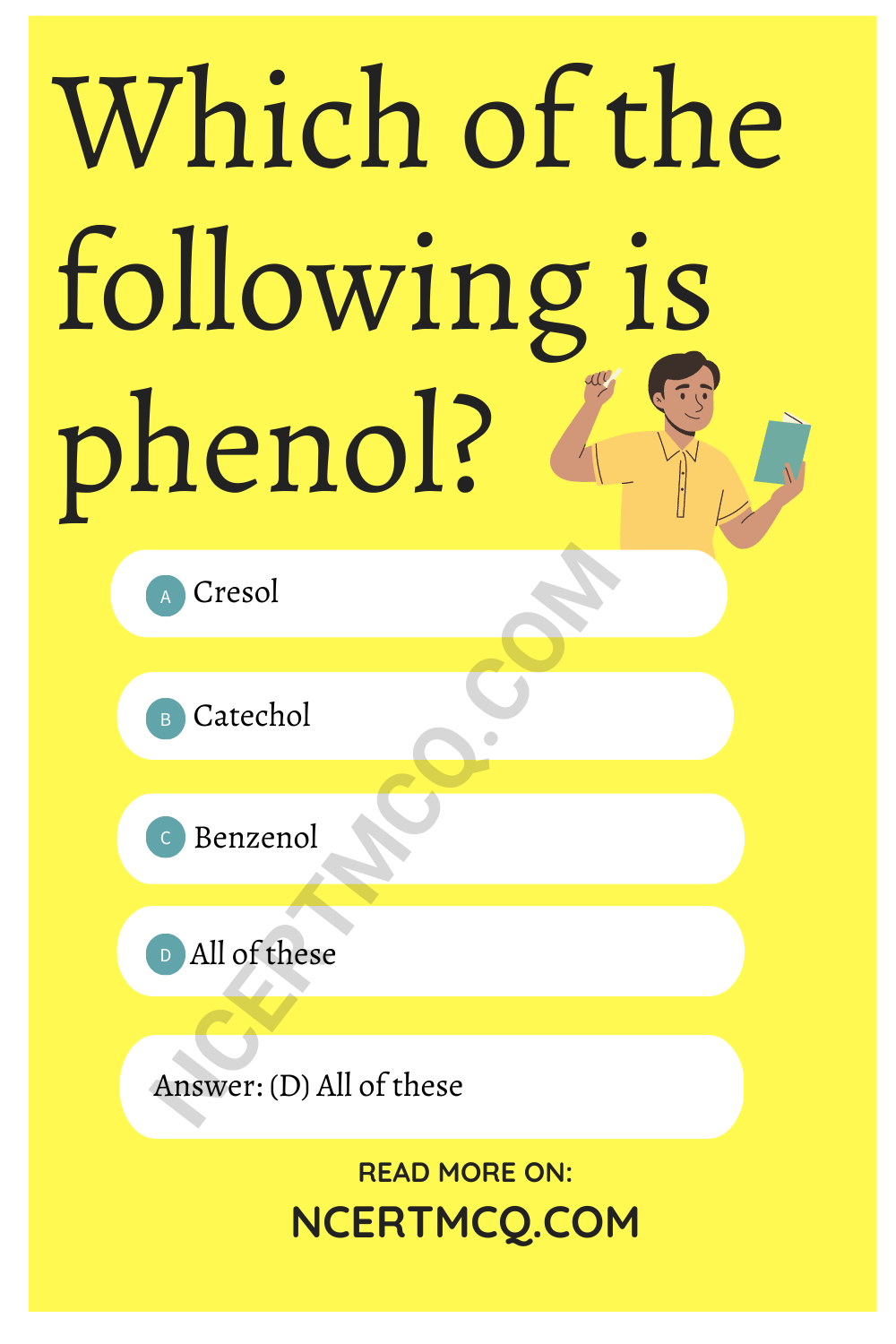
Question 33.
Benzoquinone is prepared by reaction of phenol with
(a) Na2Cr2O7, H2SO4
(b) KMnO4, H2SO4
(c) Na2CrO4,HCl
(d) K2MnO4, H2SO4
Answer
Answer: (a) Na2Cr2O7, H2SO4
Question 34.
Which of the following compounds will give tribromo derivative on treatment with bromine water?
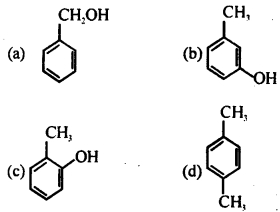
Answer
Answer: (b)
Question 35.
The major product obtained on interaction of phenol with sodium hydroxide and carbon dioxide is
(a) benzoic acid
(b) salicyaldehyde
(c) salicylic acid
(d) phthalic acid
Answer
Answer: (c) salicylic acid
We hope the given NCERT MCQ Questions for Class 12 Chemistry Chapter 11 Alcohols, Phenols and Ethers with Answers Pdf free download will help you. If you have any queries regarding Alcohols, Phenols and Ethers CBSE Class 12 Chemistry MCQs Multiple Choice Questions with Answers, drop a comment below and we will get back to you soon.
Class 12 Chemistry MCQ:
- The Solid State Class 12 MCQ
- Solutions Class 12 MCQ
- Electrochemistry Class 12 MCQ
- Chemical Kinetics Class 12 MCQ
- Surface Chemistry Class 12 MCQ
- General Principles and Processes of Isolation of Elements Class 12 MCQ
- The p-Block Elements Class 12 MCQ
- The d-and f-Block Elements Class 12 MCQ
- Coordination Compounds Class 12 MCQ
- Haloalkanes and Haloarenes Class 12 MCQ
- Alcohols, Phenols and Ethers Class 12 MCQ
- Aldehydes, Ketones and Carboxylic Acids Class 12 MCQ
- Amines Class 12 MCQ
- Biomolecules Class 12 MCQ
- Polymers Class 12 MCQ
- Chemistry in Everyday Life Class 12 MCQ
